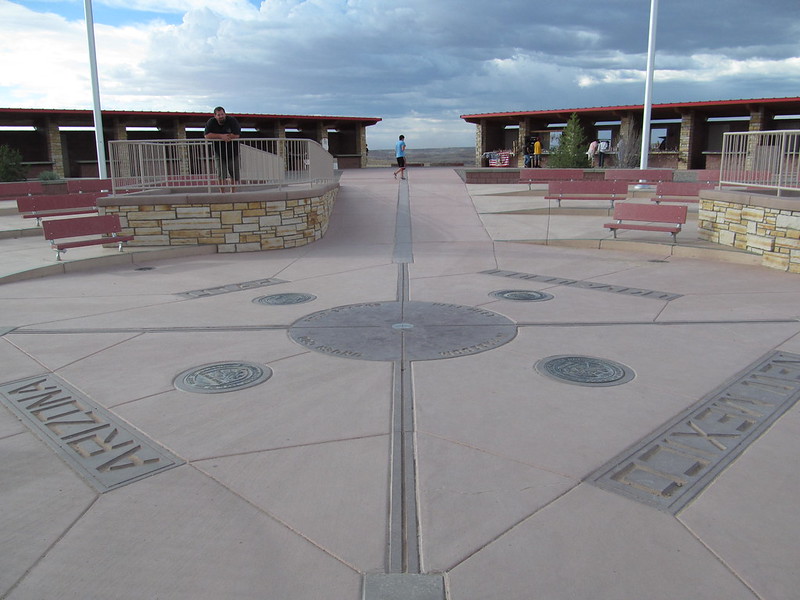Get more Southwest News & Travel Tips Here
Get more Four Corners Monument Travel Tips & News here!
Where is Four Corners Monument located?
The Four Corners Monument is located in the remote area of the Navajo Nation, near the town of Teec Nos Pos in Arizona. It sits at the confluence of four states: Arizona, New Mexico, Colorado, and Utah. The nearest town, Teec Nos Pos, is a small community that serves as a gateway to the monument. The monument is situated approximately 20 miles southwest of Shiprock, New Mexico, and about 35 miles northeast of Kayenta, Arizona. This region is rich in Native American history and culture, providing a vibrant backdrop for visitors.
Best Time to Visit Four Corners Monument
The best time to visit the Four Corners Monument is during the spring and fall months when the weather is mild and pleasant. Temperatures can soar during the summer months, often exceeding 100°F, making outdoor activities challenging. Winter can bring snow and cold temperatures, which may lead to temporary closures. Additionally, consider planning your visit around local festivals and events, which can provide a richer cultural experience. Weekdays tend to be less crowded than weekends, allowing for a more serene visit.
How to get to Four Corners Monument?
Traveling to the Four Corners Monument is relatively straightforward. The nearest major airport is the Durango-La Plata County Airport (DRO) in Colorado, located about 90 miles away. From there, visitors can rent a car and take a scenic drive to the monument. Alternatively, the Farmington International Airport (FMN) in New Mexico is approximately 75 miles away, offering regional flights and rental car services. For those seeking a more direct route, charter flights may be available from nearby cities. Additionally, Highway 160 and Highway 491 provide access to the monument, making it accessible for road trips through the region.
What to do when you arrive:
Upon arriving at the Four Corners Monument, visitors will find a visitor center that offers valuable information about the monument and the surrounding area. The center features exhibits on the history of the region, as well as local Native American culture. There are also restrooms and picnic areas available for use. For those looking to extend their stay, nearby hotels and lodges provide accommodations, while camping options are available for those who prefer a more rustic experience. Be sure to check for any seasonal hours or closures before your visit.
Getting Around Locally
Once at the Four Corners Monument, getting around the local area can be accomplished by car. The roads are well-maintained, and there are several scenic byways nearby that offer stunning views of the landscape. Renting a car is recommended for exploring the surrounding attractions, as public transportation options are limited. For those interested in guided tours, various local companies offer services that include transportation and informative insights into the region’s history and culture.
Top Things to Do and See at Four Corners Monument:
- Four Corners Monument: The main attraction itself is a brass marker set in concrete that allows visitors to stand in four states at once. It’s a perfect spot for photographs and a must-see for any traveler.
- Navajo Nation Tribal Park: Just a short drive away, this park offers breathtaking views and insights into the history and culture of the Navajo people. Visitors can explore the stunning landscapes and participate in guided tours.
- Monument Valley: Located about 60 miles from Four Corners, Monument Valley is famous for its iconic red rock formations and scenic vistas. This area is rich in Navajo history and offers various guided tours.
- Canyon de Chelly National Monument: A bit further afield, this national monument features stunning canyons and ancient cliff dwellings. Guided tours are available to learn about the area’s history and geology.
- Chaco Culture National Historical Park: Approximately 100 miles away, this UNESCO World Heritage Site is home to ancient Puebloan ruins and offers hiking trails and educational programs about the region’s archaeological significance.
Suggested Itineraries
For a comprehensive experience, consider a two-day itinerary:
- Day 1: Arrive at Four Corners Monument, take pictures, and visit the visitor center. In the afternoon, head to Monument Valley to catch the sunset.
- Day 2: Explore the Navajo Nation Tribal Park in the morning, then drive to Canyon de Chelly for a guided tour. Return to the monument area for a relaxing evening.
Permits & Fees
Visiting the Four Corners Monument requires a small entrance fee, which helps maintain the site and its facilities. Be sure to check the current fees before your visit, as they may vary. Additionally, some nearby parks and attractions may require separate permits or fees, especially for guided tours. Always carry cash, as some locations may not accept credit cards.
Nearby Day Trips & Detours
- Durango, Colorado: A charming town known for its historic downtown and the Durango & Silverton Narrow Gauge Railroad.
- Santa Fe, New Mexico: Known for its Pueblo-style architecture, vibrant arts scene, and rich history.
- Grand Canyon National Park: A few hours’ drive from Four Corners, this iconic park offers breathtaking views and numerous hiking opportunities.
Local Culture & History
The Four Corners region is steeped in the history and culture of Native American tribes, particularly the Navajo, Hopi, Zuni, and Ute peoples. The area is known for its rich traditions, art, and crafts, including weaving, pottery, and jewelry making. Visitors can learn about these cultural practices through local exhibits and interactions with artisans. The history of the region also includes significant events related to the U.S. government and Native American land treaties, making it a fascinating area for those interested in learning about the complex relationships between these cultures and the land.
Packing List & What to Bring
When visiting the Four Corners Monument and its surrounding areas, it’s essential to pack appropriately to ensure a comfortable and enjoyable experience. Here’s a comprehensive packing list to help you prepare:
- Clothing:
- Lightweight, breathable clothing for warm days
- Warm layers for cooler evenings
- Sturdy hiking boots or shoes
- Sun hat or cap for sun protection
- Rain jacket or poncho (depending on the season)
- Sun Protection:
- Sunscreen with high SPF
- Sunglasses with UV protection
- Lip balm with SPF
- Outdoor Gear:
- Daypack for hiking
- Reusable water bottle (hydration is key)
- Snacks for the trail
- Camera or smartphone for capturing memories
- Binoculars for wildlife viewing
- Health & Safety:
- First aid kit
- Insect repellent
- Any personal medications
- Camping Gear (if applicable):
- Sleeping bag suitable for the season
- Camping stove and cooking utensils
- Flashlight or headlamp with extra batteries
Always check the weather forecast before your trip and adjust your packing list accordingly. Being prepared will enhance your visit to this unique destination.
Wildlife & Nature Highlights
The Four Corners region is known for its diverse wildlife and stunning natural landscapes. Here are some highlights that you shouldn’t miss:
- Navajo Nation Wildlife: The Navajo Nation is home to a variety of wildlife, including deer, coyotes, and numerous bird species. Keep your eyes peeled for these animals during your hikes and explorations.
- Unique Flora: The area’s high desert environment supports a variety of plant life, including cacti, sagebrush, and wildflowers in the spring. Take time to appreciate the beauty of the desert ecosystem.
- Scenic Landscapes: Don’t miss the breathtaking views of Monument Valley, known for its iconic buttes and mesas, as well as the dramatic cliffs of Canyon de Chelly. Each site offers unique photography opportunities and a chance to connect with nature.
Engaging in responsible wildlife viewing and following park guidelines will help protect the natural environment while allowing you to enjoy its beauty.
Accessibility Information
The Four Corners Monument aims to be accessible to all visitors. Here are some key points regarding accessibility:
- Parking: Ample parking is available, including designated accessible parking spaces.
- Visitor Center: The visitor center is wheelchair accessible, allowing all guests to enjoy exhibits and obtain information.
- Restrooms: Accessible restrooms are available on-site for visitors with mobility challenges.
- Trails: Some nearby trails may have limited accessibility; however, the monument area itself is relatively flat and easy to navigate.
For specific accessibility inquiries or to check for any updates, it’s recommended to contact the visitor center before your visit.
FAQs
Is there an entrance fee for the Four Corners Monument?
Yes, there is a small entrance fee that helps maintain the monument and its facilities. Be sure to have cash on hand as credit cards may not be accepted.
What are the operating hours of the Four Corners Monument?
The monument typically operates from morning until sunset, but hours may vary seasonally. It’s advisable to check the official website or contact the visitor center for the most current hours.
Can I camp at the Four Corners Monument?
Camping is not permitted directly at the monument, but there are nearby campgrounds and parks that offer camping facilities. Be sure to check availability and make reservations when needed.
What should I do in case of emergency?
In case of an emergency, dial 911. Ensure you have a charged phone and familiarize yourself with the nearest hospital or medical facility location prior to your trip.
Are pets allowed at the Four Corners Monument?
Pets are generally not allowed within the monument area to ensure the safety of wildlife and other visitors. Check local regulations for pet-friendly accommodations nearby.
Additional Resources
For more information about the Four Corners Monument and the surrounding areas, you can explore the following resources:
- Navajo Nation Parks & Recreation
- National Park Service
- U.S. Forest Service
- Navajo Nation Government
- National Park Adventurers on Facebook
These resources provide valuable information about the region, including trail guides, safety tips, and cultural insights to enhance your visit.
Follow us on social media for more!

